
Recap: Gartner IT Infrastructure, Operations & Cloud Strategies Conference 2018
Multicloud, hybrid infrastructure, the edge, disaster recovery, cloud misperceptions and more: Gartner’s annual IOCS conference wrapped up recently and what an event it was—so many incredible conversations in one space over an entire week. I walked away with pages of notes and a myriad of thoughts on the topics covered. Here are some of the big ones.
The Cloudiness of “Cloud”
Ask any 10 people to define the “cloud” and you’d probably still get 10 different answers even after all these years, whether IaaS, SaaS, PaaS, private cloud, public cloud and so on. But regardless of how you’d define it, the crystal-clear message from the event was that we are living in—and will continue to live in—a multicloud world.
Mindy Cancila, Managing Vice President at Gartner, explained that cloud is not one-size-fits-all and that the most sophisticated IT organizations determine their infrastructure delivery models based on the needs and objectives of their specific applications and workloads, for reasons related to both cost and performance.
She dove deep into one particularly hot cloud topic in her keynote session: “Is the Public Cloud Cheaper Than My Data Center?”
The answer? It depends.
While the general perception may be that public cloud is cheaper, the research suggests otherwise—or at least in many scenarios. By 2020, organizations that lack cost optimization process will average 40 percent overspend in the public cloud. This may be for some a scary projection, especially when you’re talking about organizations that are spending millions of dollars annually (or even monthly) in the public cloud.
It’s important to reiterate, however, that this is situational and that some use cases can actually yield savings. Either way, IT organizations must make wise decisions when it comes to application and workload placement.
Gartner’s Five “Rs” of Multicloud
Given the wave of cloud initiatives among IT organizations, Cancila also shared Gartner’s “5 ‘Rs’” framework to assist IT leaders in making multicloud decisions.
The most impactful visual from this presentation showed how each “R” mapped to a cloud value curve; depending on which “R” you’re planning to execute, there’s a spectrum of what value you derive from moving to a public cloud service.
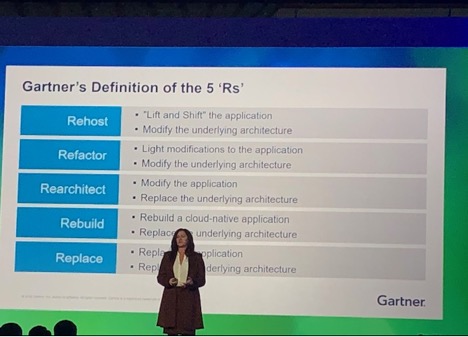
For example, if you’re simply rehosting an application—i.e., lifting and shifting—the value you will derive from a public cloud is limited or even potentially non-existent. If instead you plan to completely rebuild or replace your applications, the value derived from a public cloud service could be significant. This, yet again, highlights the need for multicloud strategy and skills in the IT organization.
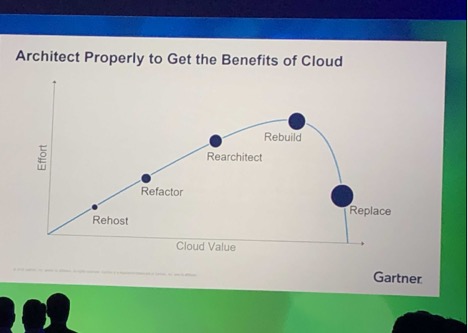
IT’s Top Challenges
Many of the sessions included live audience polling about a variety of hot-button topics. One was particularly close to my heart and persistently top-of-mind: the challenges that IT doers face in their efforts to balance the short and long terms (or in Gartner terms, Mode 1 and Mode 2 IT). N.B.: Audience sizes varied from 100 to 300+ in the individual sessions, so the sample size wasn’t bad.
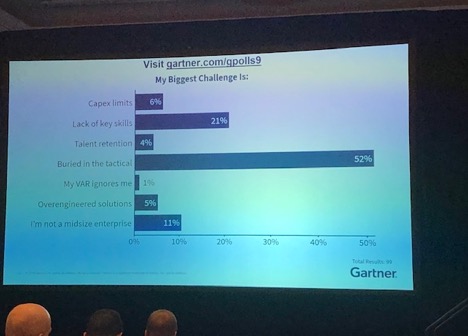
Not surprisingly, more than half the audience said that their biggest challenge was “buried in the tactical.” At INAP, we see this day in and day out, and it’s core to our belief that if we can give time back to IT teams by easing or removing the work of “keeping the lights on,” they will be freed to do more value-added and innovative work that better drives the mission and purpose of their organizations.
This supports findings from our new survey report, The State of IT Infrastructure Management: 77 percent of the IT professionals we surveyed agreed with the statement, “I could bring more value to my organization if I spent less time on routine tasks like server monitoring and maintenance.”
The second highest response was “lack of key skills.” Based on both the sessions and one-to-one conversations I was a part of, key skills mostly revolve around multivendor cloud management, hybrid infrastructure strategy and execution, and general public cloud know-how.
CIOs in the Middle
Since INAP serves mid-market enterprises very well, I was drawn to a session that was titled “How to Optimize IT Infrastructure for Midsize Enterprise Requirements.” The speaker unpacked a view of what CIOs in the mid-market face, given their size and all the advantages and disadvantages that come with that.
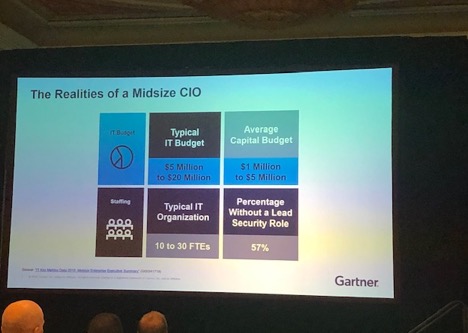
This quote stood out among the rest: “Midsize enterprises should not just be thought of as a smaller version of large enterprises.” At first you tilt your head and wonder what that actually means, since logic would say that they are. But the point was that midsize enterprises operate quite differently, both favorably and unfavorably, depending on the project or decision to be made.
That being said, there is at least one commonality among CIOs regardless of organization size: They want—and need—a bigger seat at the table and should be seen as core to digital transformation and innovation.
Gettin’ Edgy
Two out of every three conversations seemed to include the words “edge” or “edge computing.” It’s certainly a hot topic among Gartner followers and the IT community at large. Distinguished VP Analyst Thomas Bittman took the stage to educate the crowd on how Gartner actually defines the “edge.”
In short, Bittman explained that the edge is the physical location where things and people connect with the networked digital world.
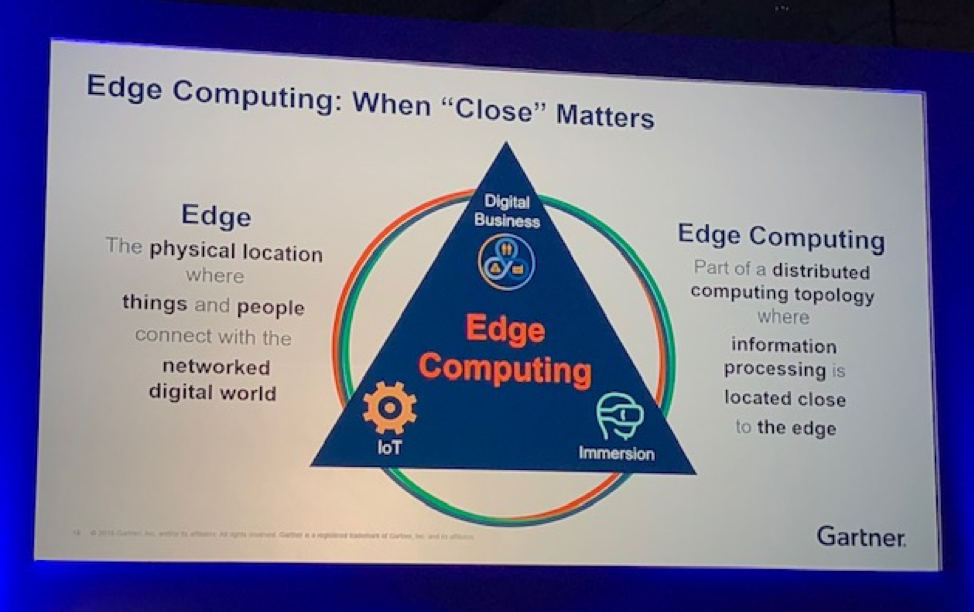
Edge computing, on the other hand, is “part of a distributed computing topology where information processing is located close to the edge.” This lines up quite well to a blog post I wrote on this very topic:
“The edge presents an exciting opportunity to explore just how close the technology can get us to the end user’s device, but high-performance applications need high-performance infrastructure from end to end.”
In other words, while the exciting stuff seems to be happening “at the edge,” none of that would be possible without a strong core of data centers and a low-latency network connecting everything.



